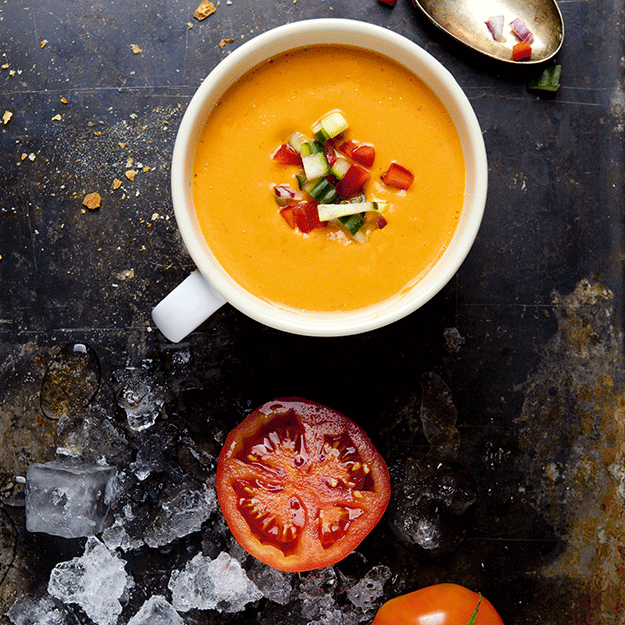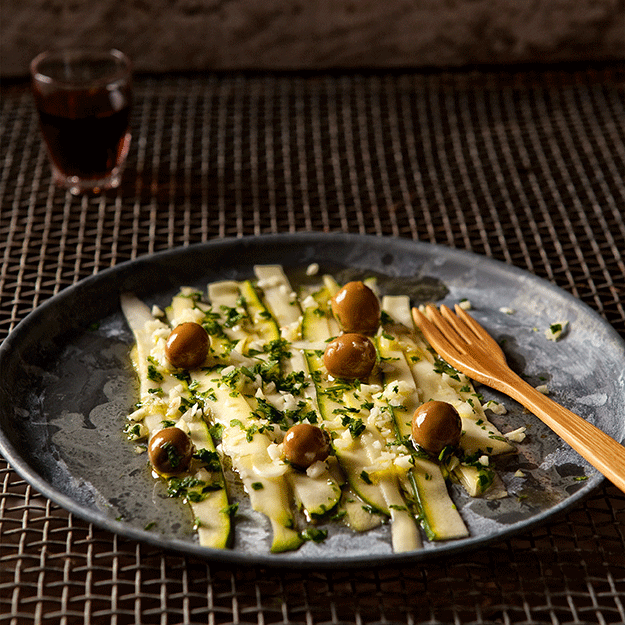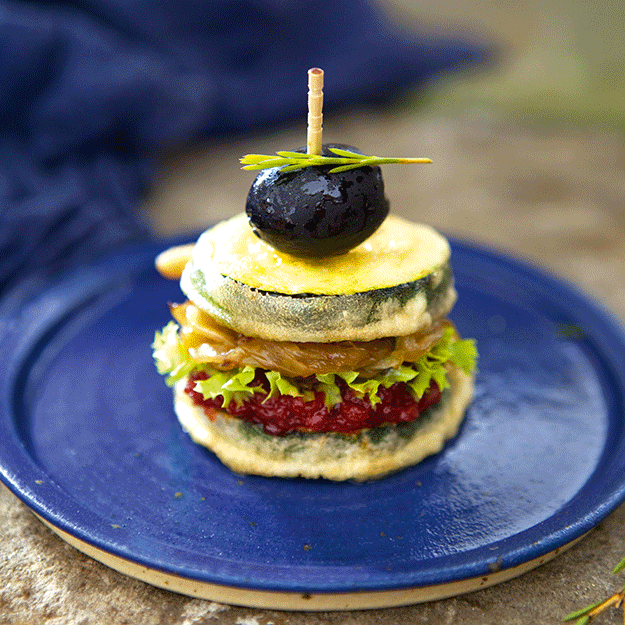.png.transform/rendition-xs/image_image%20(1).png)
Recipes For Vegans Who Love Spain
The versatility of Spanish gastronomy and cuisine is limitless. By pushing boundaries and exploiting creativity, Spanish chef Gonzalo Baró was able to create the first book ever of Spanish recipes for vegans. Discover what vegan Spain tastes like in this interview.

Text: Rodrigo García Fernández/®ICEX.
In recent years, Google searches for the term “veganism” have taken off, marking a huge distance from those for ‘vegetarianism.’” A 2017 Report Buyer summary indicated that 6% of North American consumers identify themselves openly as vegan – 500% more than in 2014. The same report states that 44% of German consumers say that they follow a “low meat” diet, as opposed to just 26% in 2014. And in the United Kingdom, The Vegan Society claims that there are more than half a million vegans. We are witnessing a trend, veganism, which will set the tone for important food habits in the future.
Within this international context, a new book has just come out that represents a landmark in publications on Spanish gastronomy in the international market. This book is Vegan Recipes from Spain, which is edited by Grub Street Publishers and already available in English and German. We interviewed its author, the photographer, blogger, Spanish chef and Berlin resident Gonzalo Baró, to learn about everything that went into this pioneering culinary and editorial project
One of the strengths of Spanish gastronomy involves taking advantage of fresh products season by season. In this sense, what can our pantry and our recipes offer those who follow a vegan lifestyle.
Our pantry is as varied as our country’s geography and climate, which is to say that you can go nuts if you want to keep up with which vegetables, legumes and fruits are in season at any given time. Vegans won't get bored in this sense, as things can't get any more diverse than this.
With regard to recipes, it’s also important to point out that people in Spain eat a lot of meat and fish, which is why you need to be somewhat creative if you want to follow a diet of only vegetables. Even so, the sheer variety of the products found here make this a relatively easy task.
My mouth starts watering just thinking about the lentils, garbanzos (chickpeas) and incredibly delicious rice dishes that we have in Spain – not to mention the amazing artichokes, tomatoes, chard and asparagus... But, as with everything else, you just have to know where to get it.
During your research into writing this book, what steps did you follow and how did you create each of the recipes featured in Vegan Recipes from Spain?

At first I thought it was going to be impossible to write a book of Spanish vegan recipes, and I had my doubts about how to tackle the project. But, step by step, I discovered more and more options opening up for me until I eventually got to the point that I had more recipes than I could include in the book.
For this to occur, I had to broaden my concept and make it more open in terms of what it means to extrapolate a country’s traditional gastronomy to a vegan diet. If we were to translate each of the dishes from our cuisine by merely replacing the meats with substitutes like soy or seitan, I don’t think we would get very far; not to mention that it would become rather tedious and monotonous. Perhaps the key was not to focus so hard on traditional dishes, but rather more on the new and contemporary possibilities – with their continual evolution and renovation – that Spanish gastronomy has to offer.
There are some recipes that are vegan by nature, like gazpacho andaluz, chard with potatoes and pimentón, and a lot of dishes made with legumes, as well as rices; but there are others that are almost impossible to “veganize,” such as bacalao a la vizcaína.
That is why I decided to recombine elements, like using a very traditional sauce with typical products from our vegetable garden. This is how recipes like berenjenas al ajoarriero (eggplant) and tortillas de brécol (broccoli) with salsa verde (both of which are typically made with fish) came to be. I spent a lot of time in the kitchen trying and experimenting with new combinations until I came up with recipes that I thought were more interesting.
Marinated Vegan Anchovies, Spanish Omelet without eggs... What role does creativity play in the process of adapting traditional Spanish recipes to the requirements of the vegan world?

I think creativity was the most significant element in the elaboration process, and the one that brought me the most headaches, given that I found myself in absolutely new territory. If I’m not mistaken, I think that this is the first book of vegan Spanish recipes ever published. Good ideas and inspirations almost never come when you sit down at the table with paper and a pen. I frequently came up with ideas at the most unexpected moments – while in the bathtub, or first thing in the morning. As with other European cuisines, animal products have an important presence in the Spanish recipe book, which is why the creative process was such an important part of writing this book. How do you manage to capture a country’s gastronomy without using meat, fish, eggs and dairy products, and also without losing its soul. It is no small task.
A lot of the recipes in the book feature Spanish olive oil as a fundamental ingredient. Do you think this product is one of the stars of the Spanish pantry?
Spanish olive oil is not the star, but rather the center of our universe! I don't know where we would be without it. We wouldn't have gazpacho, or mojos, or romesco sauce, or escabeches. It would be like having part of our identity torn away. The omnipresence of olive oil in our cuisine makes us all very proud of this product, although I think we could do much more to promote it in the rest of the world. There are incredibly excellent oils in Spain that never cross our borders. Or could it be that we like them so much that we don't want to share?
In addition to Spanish fruits, vegetables and olive oil, there is another emblematic product that enjoys a certain amount of protagonism in your book: pimentón de la Vera. What does this ingredient lend to vegan cooking?

Pimentón de la Vera has an important presence in many Spanish dishes. We use this versatile and interesting spice in an amazing variety of ways; and what a color! You do need to know how to use it correctly, however, as it has a very strong flavor and can quickly overwhelm other ingredients.
Thanks to its smoky flavor and umami, pimentón can be used to season dishes in vegan cooking, yielding characteristics that we would normally only obtain with products of animal origin, like bacon, for example. In general it lends a good kick to a lot of foods. It is my favorite spice bar none, and I always bring a tin of it with me when I travel to cook with it wherever I go. Needless to say I have had to throw out more than one t-shirt due to not sealing the tin correctly.
There is a chapter in your book dedicated to tapas and pinchos. Are we looking at a style of cooking that is yet to be discovered by vegans?
Vegans are very interested in food and in eating well in general, and so the whole tapas concept is nothing new. But if we’re talking about tapas and pinchos in their traditional Spanish version, then yes, it is still a style of cuisine that is absolutely waiting to be discovered by the vegan world. Our tapas are strongly associated with fish, sausages and cheese, but it is also a cuisine that is very open to renovation and a willingness to try new things. There are already places cropping up in Spain that are daring to broach this concept. Downstairs from my apartment in Berlin there is a very tiny Spanish bar that serves vegan tapas and pinchos once a month. You have to start somewhere...
There are numerous wineries in Spain that make wines targeted at a vegan audience, many of which fall under the definition of natural wines. Can you recommend any of them to us?
Of the latest ones that I've tried and really liked there is a red: Bobal y Merlot from
Bodegas Palmerain DO Utiel-Requena, 2015; a rosé: Rosa de Azul y Garanza from DO Navarra; and a white: Parra Jiménez Verdejo ofParra Jiménez Organic Wines from DO La Mancha.
Translation: Adrienne Smith/®ICEX.
Photographs: ®Gonzalo Baró / Grub Street Publishers.


